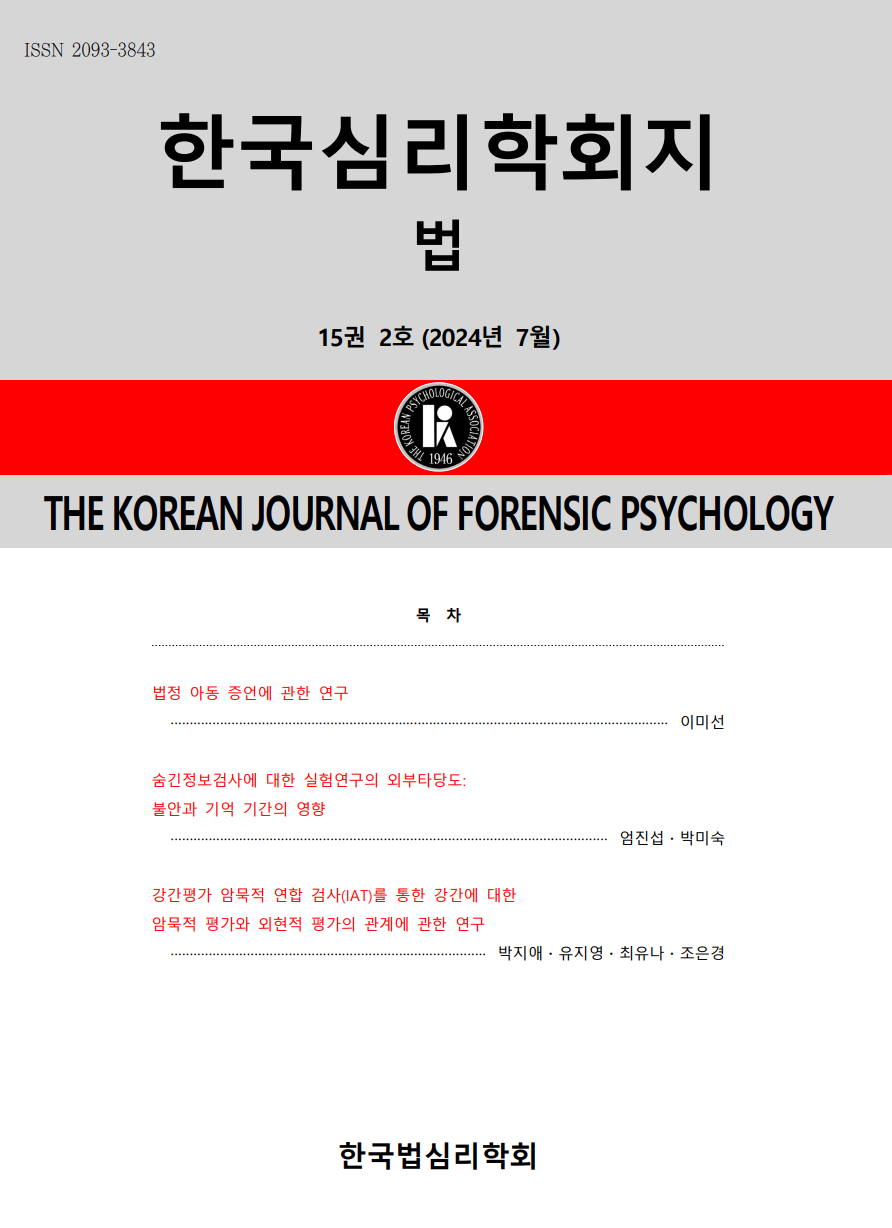open access
메뉴
open access
메뉴 ISSN : 2093-3843
ISSN : 2093-3843
Pieces of evidence that implicate the motive of the defendant for committing the alleged crime do not in itself prove the guilt of the defendant. Davis & Follette (2002) raised a concern that judges and juries would rely on the representativeness heuristic to evaluate the motive evidence and thus, overestimate its probative value which could lead to an erroneous conviction. The present study was to see whether the probative value of a motive evidence is indeed overestimated and to acquire an understanding of the way in which the probative value of a motive evidence is subjectively evaluated. One hundred thirty-one participants in their 20s read a trial scenario of a murder case in which the defendant was charged for a uxoricide. The participants rated the probability of guilt, rendered the verdict, and evaluated the probative value of the motive evidence (infidelity of the defendant) presented by the prosecutor. The trial scenario was manipulated into three levels of the strength of evidence (weak, medium, high), and each level was divided into two conditions, one with the motive evidence and the other without the motive evidence. The participants in the condition with the motive evidence did not render more verdicts of guilty nor rated the probability of guilt higher than the participants in the condition without the motive evidence. On the other hand, the participants' evaluation of the probative value of the motive evidence showed a pattern predicted by the Coherence-Based Reasoning Model (Simon, 2004; Soriano, 2003). Specifically, the strength of evidence affected the participant's conviction about the defendant's guilt and the conviction, in turn, affected the evaluation of the probative value of the motive evidence. Finally, we discussed the admissibility of the motive evidence.
Anderson, N. H. (1981). Foundations of Information Integration Theory. New York: Academic Press.
Davis, D., & Follette, W. C. (2002). Rethinking the probative value of evidence: base rates, intuitive profiling, and the “postdiction” of behavior. Law and human behavior, 26(2), 133-158.
Davis, D., & Follette, W. C. (2003). Toward an empirical approach to evidentiary ruling. Law and Human Behavior, 27(6), 661-684.
Etz, A., & Vandekerckhove, J. (2018). Introduction to Bayesian inference for psychology. Psychonomic Bulletin & Review, 25(1), 5-34.
Friedman, R. D., & Park, R. C. (2003). Sometimes what everybody thinks they know is true. Law and Human behavior, 27(6), 629-644.
Gigerenzer, G. (2000). Adaptive thinking: Rationality in the real world. Oxford University Press, USA.
Kerr, N. (1993). Stochastic models of juror decision-making. In R. Hastie (ed.), Inside the Juror: The Psychology of Juror Decision-making (pp. 116-135). New York: Cambridge University Press.
Pennington, N., & Hastie, R. (1981). Juror decision-making models: the generalization gap. Psychological Bulletin, 89, 246-287.
Pennington, N., & Hastie, R. (1986). Evidence evaluation in complex decision-making. Journal of Personality & Social Psychology, 51, 242-258.
Sanchirico, C. W. (2001). Character evidence and the object of trial. Columbia Law Review, 101, 1227-1311.
Schum, D. A., & Martin, A. W. (1993). Formal and empirical research on cascaded inference in jurisprudence. In R. Hastie (ed.), Inside the Juror: The Psychology of Juror Decision- making (pp. 136-174). New York: Cambridge University Press.
Simon, D. (2004). A third view of the black box: Cognitive coherence in legal decision making. U. Chicago Law Review, 71, 511-586.
Soriano, L. M. (2003). A modest notion of coherence in legal reasoning. A model for the European Court of Justice. Ratio Juris, 16(3), 296-323.
Wells, G. L. (2003). Murder, extramarital affairs, and the issue of probative value. Law and human behavior, 27(6), 623-627.
Wiederman, M. W. (1997). Extramarital sex: Prevalence and correlates in a national survey. Journal of Sex Research, 34, 167–174.
Wright, D. B., Strubler, K. A., & Vallano, J. P. (2011). Statistical techniques for juror and jury research. Legal and Criminological Psychology, 16(1), 90-125.